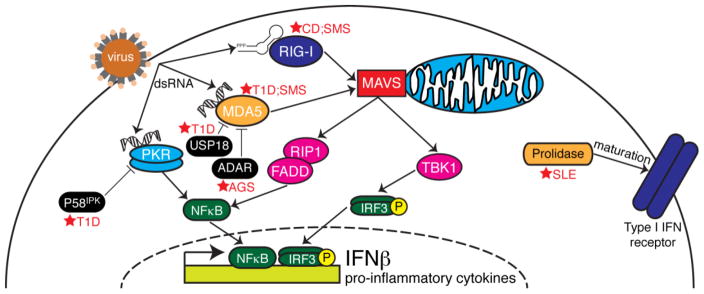Figure 1. The RNA sensing pathways.
Following virus infection, dsRNAs are produced in the cell cytosol as a byproduct of the virus life cycle. While dsRNAs activate PKR and MDA5, short (<200 bp) RNAs with a 5′ triphoosphate group activate RIG-I. MDA5 and RIG-I signal through the adapter MAVS which is located on the mitochondrial membrane. MAVS then signals though TBK1 and RIP1/FADD to activate the transcription factors IRF3 and NFκB, respectively. PKR is capable to activating NFκB. When activated, these transcription factors localize to the nucleus where they induce IFNβ and pro-inflammatory cytokines, which are secreted from the cell and bind to the type I IFN receptor and recruit specialized immune cells to the site of infection. Dysfunction in certain nodes of pathway can result in autoimmune diseases (marked by red stars). Loss of the PKR inhibitor, P58IPK results in late onset of Type I diabetes (T1D), as does downregulation of the MDA5 inhibitor, USP18, or mutations in the gene encoding MDA5. Mutations in the MDA5 inhibitor ADAR may lead to Aicardi-Goutières syndrome (AGS), while mutations in RIG-I and MDA5 may lead to Singleton-Merten syndrome (SMS). Crohn’s disease (CD) has been linked to RIG-I dysfunction. Finally, loss of prolidase, which aids in the proper maturation and surface expression of the type I IFN receptor, is linked with systemic lupus erythematosus (SLE).

